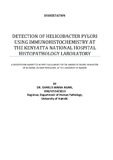| dc.contributor.author | Ngari, Charles M | |
| dc.date.accessioned | 2017-12-18T12:57:35Z | |
| dc.date.available | 2017-12-18T12:57:35Z | |
| dc.date.issued | 2017 | |
| dc.identifier.uri | http://hdl.handle.net/11295/102022 | |
| dc.description.abstract | Background: Helicobacter pylori, is a Gram negative bacteria that colonizes the gastric mucosa and is responsible for a myriad of upper gastrointestinal symptoms. This infection has a higher prevalence in the developing world with prevalence rates estimated to be as high as 80% in some regions. Several tests have been developed to diagnose the disease. Commonly, upper gastrointestinal endoscopy and biopsy are carried out to assess the cause and extent of chronic gastritis. Histochemical stains are used to detect the bacteria. However, these stains have been shown to perform poorly when compared to immunohistochemistry. There is a need to improve on the detection rates so as to properly diagnose the cause of the gastritis to enable clinicians provide appropriate treatment to their patients.
Objectives: The broad objective was to detect Helicobacterpylori in gastric mucosa biopsies using immunohistochemical methods. The secondary objectives were to review the histomorphology of gastric biopsies submitted to the Kenyatta National Hospital histopathology laboratory andto compare the histopathologic features of Giemsa-negative H. pylori biopsies with immunohistochemistry.
Design: This was a cross-sectional descriptive study carried out from March 2016 to May 2017. Thirty (30) samples were collected prospectively from August 2016 to May 2017.
Setting: The Kenyatta National Hospital Histopathology laboratory in conjunction with the Immunohistochemistry section of the department of Human Pathology, University of Nairobi.
Materials and methods: This was a descriptive cross-sectional study. Thirty samples were collected from the Endoscopy Unit of Kenyatta National Hospital and forty-eight stored samples in the Histopathology laboratory were retrieved. Haematoxylin and Eosin and Giemsa staining was routinely carried out to describe the pattern of gastritis and presence of Helicobacter pylori infection. Samples that turned out negative for infection underwent immunohistochemical staining to detect Helicobacter pylori. Data collected using a modified tool based on the Updated Sydney classification of gastritis andwas analyzed using SPSS version 21.0. Assessment was done to correlate if there was a significant improvement in the detection rates based on the various histopathologic findings seen on routine staining.
Results: A total of eighty-nine (89) gastric biopsies were selected for review, of which 11 samples were found to have been positive for H. pylori on repeat Giemsa staining. They were therefore excluded resulting in a sample size of 78 for immunohistochemistry staining. The mean
age of the patient was 48.9 years with a standard deviation of 18.7. The Male-to-Female ratio was 1:1.1.Chronic inactive gastritis was the most common Hematoxylin and Eosin finding, which was seen in 82.1% of the cases. Severe inflammation (+3) was present in half (50%) of the samples. Positivity was found in 25.6% (20 of 78) of the samples. There was low bacterial colonization in 85% (17 of 20) of cases. Medium quality of organism staining was present in 70% of the positive cases while background staining had medium quality in 83.3% of the samples.Presence of lymphoid aggregates correlated significantly with positive staining (p= 0.032, OR 3.1). No other histopathologic finding correlated significantly with immunohistochemistry positivity.
Conclusions: Immunohistochemistry is a reliable technique in detection of Helicobacter pylori. It is superior to Giemsa stain for detecting H. pylori infection, especially when lymphoid aggregates are present. Hematoxylin and eosin stain adequately displays the inflammatory and adaptive changes associated with H. pylori infection. Giemsa staining still remains the preferred technique to visualize H .pylori in gastric biopsies. | en_US |
| dc.language.iso | en | en_US |
| dc.publisher | University of Nairobi | en_US |
| dc.rights | Attribution-NonCommercial-NoDerivs 3.0 United States | * |
| dc.rights.uri | http://creativecommons.org/licenses/by-nc-nd/3.0/us/ | * |
| dc.subject | Helicobacter Pylori | en_US |
| dc.title | Detection of helicobacter pylori using immunohistochemistry at the Kenyatta National Hospital histopathology laboratory | en_US |
| dc.type | Thesis | en_US |
| dc.description.department | a
Department of Psychiatry, University of Nairobi, ; bDepartment of Mental Health, School of Medicine,
Moi University, Eldoret, Kenya | |



